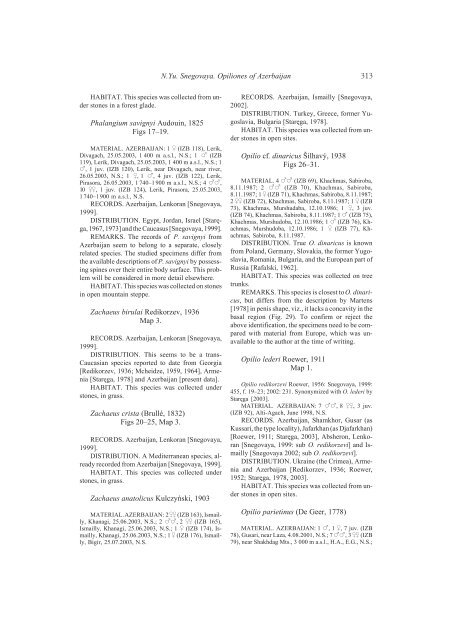Snegovaya NYu - European Society of Arachnology
Snegovaya NYu - European Society of Arachnology
Snegovaya NYu - European Society of Arachnology
Create successful ePaper yourself
Turn your PDF publications into a flip-book with our unique Google optimized e-Paper software.
HABITAT. This species was collected from under<br />
stones in a forest glade.<br />
Phalangium savignyi Audouin, 1825<br />
Figs 17–19.<br />
MATERIAL. AZERBAIJAN: 1 $ (IZB 118), Lerik,<br />
Divagach, 25.05.2003, 1 400 m a.s.l., N.S.; 1 # (IZB<br />
119), Lerik, Divagach, 25.05.2003, 1 400 m a.s.l., N.S.; 1<br />
#, 1 juv. (IZB 120), Lerik, near Divagach, near river,<br />
26.05.2003, N.S.; 1 $, 1 #, 4 juv. (IZB 122), Lerik,<br />
Pirasora, 26.05.2003, 1 740–1 900 m a.s.l., N.S.; 4 ##,<br />
10 $$, 1 juv. (IZB 124), Lerik, Pirasora, 25.05.2003,<br />
1 740–1 900 m a.s.l., N.S.<br />
RECORDS. Azerbaijan, Lenkoran [<strong>Snegovaya</strong>,<br />
1999].<br />
DISTRIBUTION. Egypt, Jordan, Israel [Starêga,<br />
1967, 1973] and the Caucasus [<strong>Snegovaya</strong>, 1999].<br />
REMARKS. The records <strong>of</strong> P. savignyi from<br />
Azerbaijan seem to belong to a separate, closely<br />
related species. The studied specimens differ from<br />
the available descriptions <strong>of</strong> P. savignyi by possessing<br />
spines over their entire body surface. This problem<br />
will be considered in more detail elsewhere.<br />
HABITAT. This species was collected on stones<br />
in open mountain steppe.<br />
Zachaeus birulai Redikorzev, 1936<br />
Map 3.<br />
RECORDS. Azerbaijan, Lenkoran [<strong>Snegovaya</strong>,<br />
1999].<br />
DISTRIBUTION. This seems to be a trans-<br />
Caucasian species reported to date from Georgia<br />
[Redikorzev, 1936; Mcheidze, 1959, 1964], Armenia<br />
[Starêga, 1978] and Azerbaijan [present data].<br />
HABITAT. This species was collected under<br />
stones, in grass.<br />
Zachaeus crista (Brullé, 1832)<br />
Figs 20–25, Map 3.<br />
RECORDS. Azerbaijan, Lenkoran [<strong>Snegovaya</strong>,<br />
1999].<br />
DISTRIBUTION. A Mediterranean species, already<br />
recorded from Azerbaijan [<strong>Snegovaya</strong>, 1999].<br />
HABITAT. This species was collected under<br />
stones, in grass.<br />
Zachaeus anatolicus Kulczyñski, 1903<br />
MATERIAL. AZERBAIJAN: 2 $$ (IZB 163), Ismailly,<br />
Khanagi, 25.06.2003, N.S.; 2 ##, 2 $$ (IZB 165),<br />
Ismailly, Khanagi, 25.06.2003, N.S.; 1 $ (IZB 174), Ismailly,<br />
Khanagi, 25.06.2003, N.S.; 1 $ (IZB 176), Ismailly,<br />
Bigir, 25.07.2003, N.S.<br />
N.Yu. <strong>Snegovaya</strong>. Opiliones <strong>of</strong> Azerbaijan<br />
313<br />
RECORDS. Azerbaijan, Ismailly [<strong>Snegovaya</strong>,<br />
2002].<br />
DISTRIBUTION. Turkey, Greece, former Yugoslavia,<br />
Bulgaria [Starêga, 1978].<br />
HABITAT. This species was collected from under<br />
stones in open sites.<br />
Opilio cf. dinaricus Šilhavý, 1938<br />
Figs 26–31.<br />
MATERIAL. 4 ## (IZB 69), Khachmas, Sabiroba,<br />
8.11.1987; 2 ## (IZB 70), Khachmas, Sabiroba,<br />
8.11.1987; 1 $ (IZB 71), Khachmas, Sabiroba, 8.11.1987;<br />
2 $$ (IZB 72), Khachmas, Sabiroba, 8.11.1987; 1 $ (IZB<br />
73), Khachmas, Murshudaba, 12.10.1986; 1 $, 3 juv.<br />
(IZB 74), Khachmas, Sabiroba, 8.11.1987; 1 # (IZB 75),<br />
Khachmas, Murshudoba, 12.10.1986; 1 # (IZB 76), Khachmas,<br />
Murshudoba, 12.10.1986; 1 $ (IZB 77), Khachmas,<br />
Sabiroba, 8.11.1987.<br />
DISTRIBUTION. True O. dinaricus is known<br />
from Poland, Germany, Slovakia, the former Yugoslavia,<br />
Romania, Bulgaria, and the <strong>European</strong> part <strong>of</strong><br />
Russia [Rafalski, 1962].<br />
HABITAT. This species was collected on tree<br />
trunks.<br />
REMARKS. This species is closest to O. dinaricus,<br />
but differs from the description by Martens<br />
[1978] in penis shape, viz., it lacks a concavity in the<br />
basal region (Fig. 29). To confirm or reject the<br />
above identification, the specimens need to be compared<br />
with material from Europe, which was unavailable<br />
to the author at the time <strong>of</strong> writing.<br />
Opilio lederi Roewer, 1911<br />
Map 1.<br />
Opilio redikorzevi Roewer, 1956: <strong>Snegovaya</strong>, 1999:<br />
455, f. 19–23; 2002: 231. Synonymized with O. lederi by<br />
Starêga [2003].<br />
MATERIAL. AZERBAIJAN: 7 ##, 8 $$, 3 juv.<br />
(IZB 92), Alti-Agach, June 1998, N.S.<br />
RECORDS. Azerbaijan, Shamkhor, Gusar (as<br />
Kussari, the type locality), Jafarkhan (as Djafarkhan)<br />
[Roewer, 1911; Starêga, 2003], Absheron, Lenkoran<br />
[<strong>Snegovaya</strong>, 1999: sub O. redikorzevi] and Ismailly<br />
[<strong>Snegovaya</strong> 2002; sub O. redikorzevi].<br />
DISTRIBUTION. Ukraine (the Crimea), Armenia<br />
and Azerbaijan [Redikorzev, 1936; Roewer,<br />
1952; Starêga, 1978, 2003].<br />
HABITAT. This species was collected from under<br />
stones in open sites.<br />
Opilio parietinus (De Geer, 1778)<br />
MATERIAL. AZERBAIJAN: 1 #, 1 $, 7 juv. (IZB<br />
78), Gusari, near Laza, 4.08.2001, N.S.; 7 ##, 3 $$ (IZB<br />
79), near Shakhdag Mts., 3 000 m a.s.l., H.A., E.G., N.S.;
















